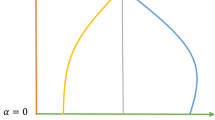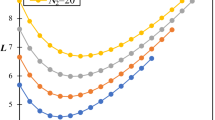Abstract
In this article, a continuous review finite-source inventory system with single-server service facility is studied. The arrival of customers for unit item follows quasi-random process. The service time to process the item follows phase-type distribution. (s, S) policy is adopted for replenishing an order. The lead time follows phase-type distribution. An arriving customer who finds waiting hall full, (s)he either enters into the pool or leaves the system immediately according to a Bernoulli trial. A pooled customer is selected according to a prefixed selection policy. The joint probability distribution of the inventory level, number of customers in the pool and number of customers in the waiting hall is obtained in the steady-state case. Various stationary system performance measures are derived and total expected cost rate is calculated. Some numerical examples including optimality of the total expected cost rate are also presented.


Similar content being viewed by others
References
Alfa, A., & Sapna Isotupa, K. (2004). An \({M/PH/k}\) retrial queue with finite number of sources. Computers and Operations Research, 31(9), 1455–1464.
Arivarignan, G., Yadavalli, V. S. S., & Sivakumar, B. (2008). A perishable inventory system with multi-server service facility and retrial customers. In N. Ravichandran (Ed.), Management science and practice (pp. 3–27). New Delhi: Allied Publishers pvt. Ltd.
Artalejo, J. (1998). Retrial queues with a finite number of sources. Journal of Korean Mathematics Society, 35(3), 503–526.
Artalejo, J., & Lopez-Herrero, M. (2007). A simulation study of a discrete-time multiserver retrial queue with finite population. Journal of Statistical Planning and Inference, 137, 2536–2542.
Audet, C., & Dennis, J. E. (2006). Mesh adaptive direct search algorithms for constrained optimization. SIAM Journal on Optimization, 17(1), 188–217.
Audet, C., & Hare, W. (2017). Derivative-free and blackbox optimization, springer series in operations research and financial engineering. Heidelberg: Springer.
Berman, O., Kaplan, E. H., & Shimshak, D. G. (1993). Deterministic approximations for inventory management at service facilities. IIE Transactions, 25, 98–104.
Berman, O., & Kim, E. (1999). Stochastic inventory policies for inventory management of service facilities. Stochastic Models, 15, 695–718.
Berman, O., & Sapna, K. P. (2000). Inventory management at service facilities for systems with arbitrarily distributed service times. Stochastic Models, 16, 343–360.
Bijvank, M., & Vis, I. F. (2011). Lost-sales inventory theory: A review. European Journal of Operational Research, 215, 1–13.
Falin, G., & Artalejo, J. (1998). A finite source retrial queue. European Journal of Operational Research, 108, 409–424.
Goyal, S., & Giri, B. (2001). Recent trends in modeling of deteriorating inventory. European Journal of Operational Research, 34, 1–16.
Jenifer, J., & Sivakumar, B. (2014). A comparative study of the inventory system with service facility and postponed demands. Journal of System Science and System Engineering, 23(2), 176–195.
Jinbiao, W., Liu, Z., & Yang, G. (2011). Analysis of the finite source \({MAP/PH/N}\) retrial \({G}\)-queue operating in a random environment. Applied Mathematical Modelling, 35(3), 1184–1193.
Keerthana, M., Saranya, N., & Sivakumar, B. (2020). A stochastic queueing - inventory system with renewal demands and positive lead time. European Journal of Industrial Engineering, 14(4), 443–484.
Keerthana, M., Sivakumar, B., & Manuel, P. (2022). An inventory system with postponed and renewal demands. International Journal of Systems Science: Operations & Logistics, 9(2), 180–198.
Krishnamoorthy, A., & Divya, V. (2020). (M, MAP)/(PH, PH)/1 queue with non-preemptive priority and working vacation under N-policy. Journal of the Indian Society for Probability and Statistics, 21, 69–122.
Krishnamoorthy, A., & Islam, M. E. (2004). (\(s\),\(S\)) inventory system with postponed demands. Stochastic Analysis and Application, 22(3), 827–842.
Krishnamoorthy, A. & Jose, K. (2007). Comparison of inventory systems with service, positive lead-time, loss and retrial of demands. Journal of Applied Mathematics and Stochastic Analysis, pp 1–23.
Krishnamoorthy, A., Lakshmy, B., & Manikandan, R. (2011). A survey on inventory models with positive service time. OPSEARCH, 48(2), 153–169.
Krishnamoorthy, A., Shajin, D., & Narayanan, V. (2019). Inventory with positive service time: A survey. In In. V. Anisimov & N. Limnios (Eds.), Advanced trends in queueing theory: Series of books ‘Mathematics and Statistics’. London: Wiley.
Manuel, P., Sivakumar, B., & Arivarignan, G. (2007). Perishable inventory system with postponed demands and negative customers. Journal of Applied Mathematics and Decision Sciences, 2007, 1–12.
Manuel, P., Sivakumar, B., & Arivarignan, G. (2008). Perishable inventory system with service facilities and retrial customers. Computers & Industrial Engineering, 54(3), 484–501.
Melikov, A., & Molchanov, A. (1992). Stock optimization in transportation/storage systems. Cybernetics and Systems Analysis, 28(3), 484–487.
Montoison, A., Pascal, P., & Salomon, L. (2020). NOMAD.jl: A Julia interface for the constrained blackbox solver NOMAD. https://github.com/bbopt/NOMAD.jl.
Nahmias, S. (1982). Perishable inventory theory: A review. Operations Research, 30, 680–708.
Neuts, M. (1981). Matrix-geometric solutions in stochastic models: An algorithmic approach. Baltimoren: Johns Hopkins University Press.
Padmavathi, I., Lawrence, A. S., & Sivakumar, B. (2016). A finite-source inventory system with postponed demands and modified M vacation policy. OPSEARCH, 53(1), 41–62.
Raafat, F. (1991). A survey of literature on continuously deteriorating inventory models. Journal of Operational Research Society, 42, 27–37.
Radhamani, V., Sivakumar, B., & Shophia Lawrence, A. (2016). A comparative study on replenishment policies of inventory system with postponed demands. International Journal of Systems Science: Operations & Logistics, 3(1), 13–33.
Schwarz, M., Sauer, C., Daduna, H., Kulik, R., & Szekli, R. (2006). \({M/M/1}\) queueing systems with inventory. Queueing Systems, 54, 55–78.
Shah, N., & Shah, Y. (2000). Literature survey on inventory models for deteriorating items. Ekonomski Anali, 44, 221–237.
Shophia Lawrence, A., Sivakumar, B., & Arivarignan, G. (2013). A perishable inventory system with service facility and finite source. Applied Mathematical Modelling, 37, 4771–4786.
Sivakumar, B. (2009). A perishable inventory system with retrial demands and a finite population. Journal of Computational and Applied Mathematics, 224(1), 29–38.
Sivakumar, B., & Arivarignan, G. (2008). An inventory system with postponed demands. Stochastic Analysis and Applications, 22(3), 827–842.
Sivakumar, B., & Arivarignan, G. (2009). A stochastic inventory system with postponed demands. Performance Evaluation, 66, 47–58.
Suganya, C., Lawrence, A. S., & Sivakumar, B. (2018). A finite-source inventory system with service facility, multiple vacations of two heterogeneous servers. International Journal of Information and Management Sciences, 29(3), 257–277.
Takagi, H. (1993). Queueing analysis: a foundation of performance evaluation volume 2: finite systems. Amsterdam: North-Holland.
Wüchner, P., Sztrik, J., & De Meer, M. (2009). Finite-source \({M/M/S}\) retrial queue with search for balking and impatient customers from the orbit. Computer Networks, 53(8), 1264–1273.
Yadavalli, V. S. S., Sivakumar, B., Arivarignan, B., & Adetunji, O. (2011). A multi-server perishable inventory system with negative customer. Computers & Industrial Engineering, 61(2), 254–273.
Yadavalli, V. S. S., Sivakumar, B., Arivarignan, B., & Adetunji, O. (2012). A finite source multi-server inventory system with service facility. Computers & Industrial Engineering, 13(4), 739–753.
Author information
Authors and Affiliations
Corresponding author
Additional information
Publisher's Note
Springer Nature remains neutral with regard to jurisdictional claims in published maps and institutional affiliations.
Appendices
Appendix 1
In this appendix, we provide the general structure of the sub matrices of the infinitesimal generator P and their dimensions.
Except the dimension of matrix, \(\tilde{B_{00}}\) is same as \(B_{00}\).
Except the dimension of matrix, \({\tilde{B}}_{10}\) is same as \(B_{10}.\)
Except the dimension of matrix, \({\tilde{B}}_{20}\) is same as \(B_{20}.\)

where
Except the dimension of matrix, \(B_{30}\) is same as \(\tilde{B_{30}}.\)
Except the dimension of matrix, \({\tilde{C}}_{01}\) is same as \({\tilde{C}}_{02}.\)

where
\(\text{ for } \ k=1,2,\ldots ,M-1\)
\(\text{ for } \ k=1,2,\ldots ,M-1\)

where
\(\text{ for } \ k=1,2,\ldots ,M-1,\)
\(\text{ for } \ k=1,2,\ldots ,M-1,\)
The dimensions of the above matrices are given in the Table 10.
Appendix 2
In this appendix, we have provided a detailed study of the proposed model with a simple example given below. For this, we fix \(N = 7, K = 3, L=2, M=4, S=5, s=2.\) We obtain the matrix P with following sub-matrices:








From the structure of P that the homogeneous continuous time Markov chain \(Z(t)=\left\{ (L(t),X(t),Y(t), t\ge 0\right\} \) on the finite state space E is irreducible. The steady state probability distribution of this process, denoted by \(\pi _{<0>}, \pi _{<1>},\pi _{<2>},\pi _{<3>},\pi _{<4>}\) and \(\pi _{<5>}\). We can compute \(\Pi \) values by solving the equation \(\Pi P = 0 \) and \(\Pi e= 1\). Table 11 gives the values of the vector \(\Pi \) which are computed using Julia software.
In order to compute system parameter measures, we fix parameter values as \(p=\frac{3}{4}; q=\frac{3}{4}; \gamma =\frac{4}{5}; \mu =\frac{16}{5}; \beta =\frac{1}{2};\) and hence the system parameter measures are calculated as \(\eta _{I} = 0.9741195, \eta _{R} =0.4336778, \eta _{TR} = 0.2265795, \eta _{P} = 3.05270895, \eta _{W} = 2.1897712, \eta _{L} = 0.0812148.\) After computing the system parameter measures, we have obtained the total expected cost \(TC= 4.979400146\) by fixing the cost parameters as \(c_{h} = 0.0015; c_{s}=1.8; c_{tr}=0.5; c_{wp} = 0.4; c_{wb} = 1.3; c_{l} = 0.2.\)
Rights and permissions
Springer Nature or its licensor (e.g. a society or other partner) holds exclusive rights to this article under a publishing agreement with the author(s) or other rightsholder(s); author self-archiving of the accepted manuscript version of this article is solely governed by the terms of such publishing agreement and applicable law.
About this article
Cite this article
Sebastian Arockia Jenifer, J., Shophia Lawrence, A. & Sivakumar, B. A finite-source inventory system with service facility and postponed demands. Ann Oper Res 331, 867–897 (2023). https://doi.org/10.1007/s10479-022-05041-3
Accepted:
Published:
Issue Date:
DOI: https://doi.org/10.1007/s10479-022-05041-3




